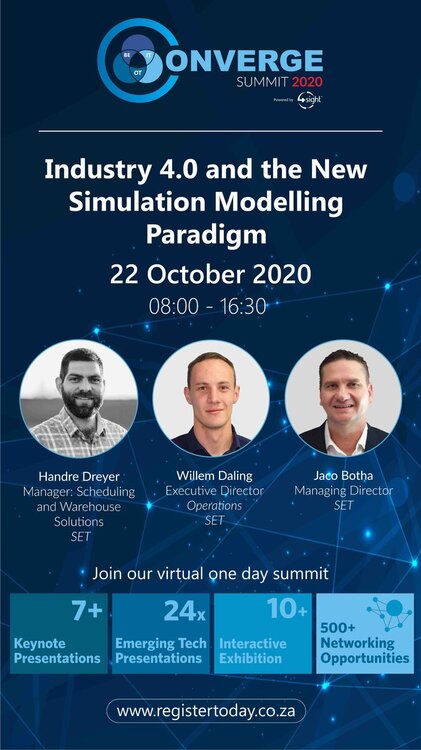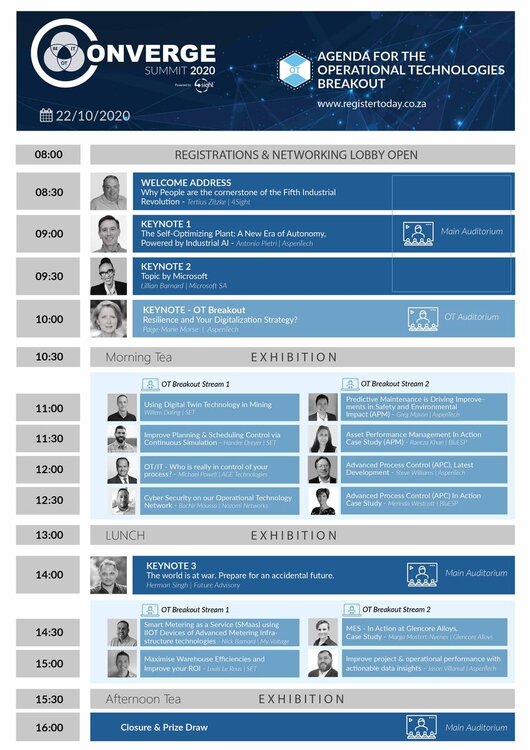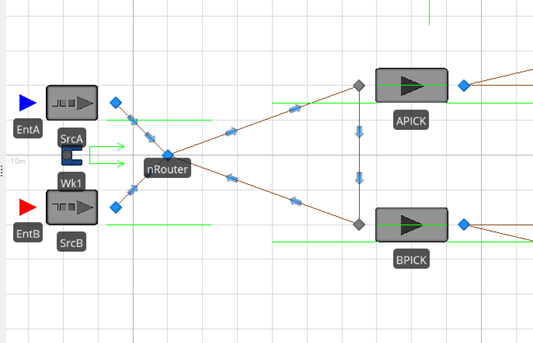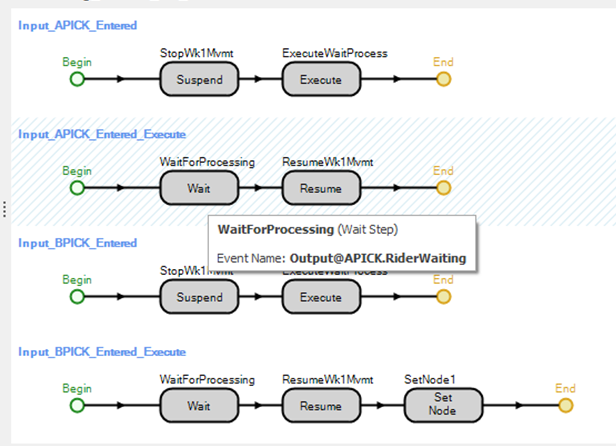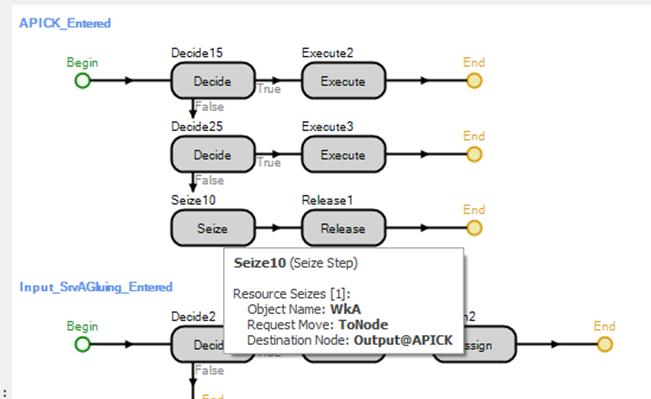Search the Community
Showing results for 'event parameters'.
-
Before you start adding state variables to a library object, I suggest that you first familiarize yourself with all of the existing states. One easy way to do this is to instantiate the object (e.g., Worker1) and then go to any expression field and type "Worker." and look at the list. In the case of Worker, there are over 100 states, functions, and properties built-in to the Worker object. Another way is to subclass the Worker, then go to the Definitions tab of the MyWorker object and you can see all of the built-in definitions by category: There is a pretty good chance that what you need is already there. But if not, use the same screen illustrated above and add whatever state (or property, event, ...) that you need. As far as referencing or assigning that custom state or a built-in state, it is done using ObjectName.StateName. For example if you added a state named TimeStartedMove to MyWorker, and you wanted to assign that value, you might assign MyWorker.TimeStartedMove to TimeNow. The tricky part, especially with more complex objects like Workers, is to determine exactly when/how to assign that value. Sometimes you can interact with the model itself to insert an Assign at the correct location (let's say in the Loaded Add-on Process). Or sometimes you might need to override the process logic in your custom object. The SimBits RecordDistanceTraveled and ElectricVehicle are examples to review.
-
Referenced definition type and executing type error
ViniciusF replied to Gashi's topic in SI General Discussions
Hi! I don't think you need to save those times stamps on MyVehicle. I would suggest you to use processes that triggers when the entity leaves the Output Buffer of the source and enters the Input Buffer of the server. To do that, create two process with the corresponding Triggering Event Name: Source1.OutputBuffer.Exited or Server1.InputBuffer.Entered, saving time stamps directly on the MyModelEntity. -
How to track the different values of ModelEntity.Cost
Gashi posted a topic in SI General Discussions
Hello, i am using the Financials Properties in Simio. In this simple model, i have parameters for different cost types (see in the picture). All the cost types are used with the default financial states. The dynamic label of the ModelEntiy shows the expression "ModelEntity.Cost", so it roll all the cost components up in the particular entity. The entity in the processing has a value of 76.84. (rolled up) Now my question is, is it possible to see all the cost components for all my model entity, for example as a expression in a floor label or in a data table. Thank you! -
Hi everyone, I am trying to model entities moving from 10 origins (sources) to 10 destinations (sinks). The entities are simultaneously created according to a certain mix (Entity1 (85%), Entity2 (10%), and Entity3 (5%). However, the number of entities created per event is according to a certain distribution. There is an OD-matrix that captures the number of entities moving from origin to a specific destination. Let's say there are 10 destinations, than the destinations of the Entities are determined according to the OD-matrix: Entity1 and Entity2 can move to any of of the sinks. Entity3 can only move to one specific sink. One solution I came up with was to add weights to Connectors and assign destinations using TransferNodes, but I think that this is very inefficient. I then started to work with DataTables, but I cannot figure out how to probabilistically assign the destinations of the entities. My question is: how to model the probabilistic destination assignment of Entities using DataTables in such a way that it is relatively easy and flexible to add or remove Sources/Sinks? I have added the model for you to see, I hope that you can help me! Many thanks in advance Simple_OD_creation.spfx
-
How to increase the distence between entity to entity ?
jzhou replied to River's topic in SI General Discussions
@River Maybe you can use a Timer element and set its Interval type to Arrival Table and use Timer's event to trigger a Process, within this process, you can do anything you want use process steps. -
-
I want to create a list of materials from data table. I can refer to inventory replenishment policy from table by adding by adding "replenishment policy" property from data tables. But how do I define the default values of Re order point and Up to Level parameters for these auto-created materials? I cannot see such option even in the built in Material Table Scheme. Any help is really appreciated. Kind regards
- 1 reply
-
- materials
- data tables
- (and 6 more)
-
I have a problem with producing/consuming within my TaskSequence. I need multiple task operation (prepare -> work -> clean -> produce), where I'm also consuming/producing material defined inside my BOM table. When I'm trying to reference material requirements on the BOM table I get an error: "Could not determine the row to use in the referenced table or repeat group ...", references to the processing time and other parameters are working fine. If I set the task sequence reference to the BOM table, then material requirements works OK, but I could not add more than 1 task. I'm using version 15.241.27814 . Best regards, Žan
-
Job Description Energetic and personable professional who applies operational research to best utilize workforce, data, technology, and other resources to achieve maximum productivity within budgetary constraints. Guides current practices and facilitates through more efficient and effective ways to achieve operational excellence. Experience in discrete event simulation, agent-based modeling, and predictive analytics is a plus Job Responsibility Develops metrics, creates dashboards, reports, and identifies areas of improvement across the organization using various analytical tools and techniques. Identifies current process gaps through the use of observations, data collection, data analysis, process ideologies and communication with management and frontline staff. Identifies issues, root causes, strategies for improvement, and development of implementation and sustainment plans. Supports project management, development of project timelines, and follow-up action items for process improvement initiatives. Develops the summary of findings, recommendations, and action plans to management. Applies principles, techniques and procedures to the design and implementation of technology and process solutions (i.e. Lean, Six Sigma, Kaizen). Supports development of principles and methods for curriculum and training design, teaching and instruction for individuals and groups, and the measurement of training effects. Work assignments are varied and require interpretation and independent decisions on the course of action. Decisions may be guided by precedent, previous experience, and known professional guidelines and compliance requirements. Often required to interpret policies, standards, requirements, and approaches to meet work objectives. Regularly exercises independent judgment on matters of significance within defined procedures to determine appropriate actions/approaches. Normally receives general instructions on routine work, and detailed instructions on new projects or assignments. Performs related duties as required. All responsibilities noted here are considered essential functions of the job under the Americans with Disabilities Act. Duties not mentioned here, but considered related are not essential functions. Job Qualification Bachelor’s Degree or equivalent combination of education and related experience as Continuous Improvement Engineer, Industrial Engineer, Operations Process improvement Engineer, Process Engineer, or Lean Six Sigma Black Belt. 1-3 years of technical experience, required. Technical Skill preferred: Experience in discrete event simulation (preferably Simio), Lean, Black Belt Six Sigma Certificate, Statistical Analysis, Graphical Analysis, Facilitation, and Presentation Skills, Operational Research, Programing (i.e., R or Python), Predictive Modeling, Agile Project Management. Here is the link to apply: https://jobs.northwell.edu/job-3/16580688/process-improvement-engineer-lake-success-ny/
-
Hi John, The entity is requesting a ride from the vehicle and the vehicle will seize the driver if available. However, if the vehicle is unable to seize the driver, it will reject the ride request and the entity will move to the Global Visit Request Queue, as you are seeing. You can attempt to have the Vehicle check again if it can now pick up the entity, and it will run the process to check if a driver is available. To have the Vehicle check the Global Request Queue to see if it can give a ride, use a PlanVisit step. Ensure that the Vehicle, in this case Vehicle_A, is the object executing this step. By default, the Vehicles are not aware if the Driver they need becomes available. You might consider using a Subscribe step on the Vehicle's OnInitialized process. This Subscribe step can watch for an Event and if that Event occurs, can trigger a related process. For example, the Vehicle might wait for the Driver.Released Event. When this Event occurs Process1 could run. In Process1, the Vehicle could execute the PlanVisit step. For more information, I recommend the Help pages in the Simio Reference Guide titled "PlanVisit" and "Subscribe". Happy Modeling!
-
Conditional entity release one at a time
gocken replied to Amine3225's topic in SI General Discussions
Hi Amine, I have defined a new process named process1 which is triggered by Input@BUFFER_ST_1.Entered event. Then, I used interrupt step (in process 1) to get one entity from processing station whenever process 1 is triggered. Note that I set the processing time of BUFFER_ST_2 server to infinity to hold entitys until Input@BUFFER_ST_1.Entered event is occured. I am not sure if setting this to infinity is a problem?. Other than this everything is ok and it seems it works. Buffer varianti trazioni V2.spfx -
My simulation is looking at maintaining inventory levels at multiple servers across a road network. Inventory is delivered via transports and is processed at each station at a rate of 1 item per hour (constant). What I am trying to do is to run some experiments to determine effects of different parameters on delivery system performance (ability to maintain inventory at (between 0-12) at each server location for the duration (72 hours is the current short test case). I have my responses set up to report Input@Server1.AssociatedStationLoad however the numbers are being listed between 0 and 1 instead of 0 and 12. Additionally, in the experiment output I get a 1 or 0 per server per scenario iteration. What I need to see is if any (and what) server hits 0 at any given time by having an output give an inventory level at current time for the duration of each run. Any advice?
-
Import export input parameters please.
-
About the job Position: Industrial Simulation Services, Simulation Developer Location: Kitchener, Ontario Experience: 3-5 Years of relevant work experience Division: OTTO Motors Area of Study: Industrial/ Mechanical/ Mechatronics/ Systems Engineering NOTE: Must be able to travel to the U.S at time of application. About Clearpath Robotics Inc. Clearpath Robotics Inc. develops the future of robotics technology through development and sale of industry-leading self-driving technology, products, and services to over 500 of the world’s most innovative brands. Proprietary hardware, software, and services are delivered through the company’s research and industrial divisions: Clearpath Robotics and OTTO™ Motors. Clearpath Robotics Inc. is an award-winning company with recent awards including Robotics Business Review Top 50 Robotics Company, Edison Award for Innovation, Business Insider Top 40 under 40, and Canada’s Top 100 Employers. About Clearpath Robotics Research Solutions Clearpath Robotics’ research solutions group is a global leader in unmanned vehicle robotics for research and development, and provides hardware, software, and services to enable self-driving vehicle development, deployment, and operation. Clearpath Robotics works with over 500 of the world’s most innovative brands in over 40 countries, serving markets that span mining, military, agriculture, aerospace, and academia. Visit Clearpath Robotics atwww.clearpathrobotics.com. About OTTO™ Motors OTTO™ Motors is making material handling in industrial settings safer, easier, and more efficient through development of hardware and software that automates movement of goods in busy factories and warehouses. The company’s industry-leading self driving technology provides automated and on-demand material handling in the most demanding industrial environments, spanning automotive, medical device, aerospace, logistics, and more. Customers trusting their mission-critical material handling needs to OTTO Motors include Fortune 100 brands GE, Toyota, and Caterpillar. For more information visitwww.ottomotors.com. About the Job Having 10’s of robots run around our offices is great, but having hundreds of robots running around inside our computers is even better. Rich simulation environments offer a wide range of benefits to many aspects of our business: fast research, development and validation, sharp marketing tools and strong customer experience / support. We're looking for a Simulation Developer to create and run simulations that will help us optimize our robot fleets and system solutions. As a part of the Industrial Simulation Services (ISS) team, you will act as a subject matter expert and lead modeling and simulation activities. The ISS team works closely with our Systems Engineering, Applications Engineering and Project Management team, to support overall solution design from initial concept all the way to full system design and deployment. You will be building material flow strategies (based on self-driving vehicles) for products already in our arsenal and ones that do not yet exist. Your goal is to develop accurate and robust simulations to evaluate design, lower risk, and enhance the elegance of our solutions to fuel our growth. Primary Responsibilities Creating discrete event simulations for real and hypothetical systems, estimating fleet sizes, identifying traffic bottlenecks, testing what-if scenarios to optimize performance of robot fleets Consulting with project leads, sales team members and customers to obtain understanding of the requirements and to collect the necessary inputs Advising on simulation based metrics to evaluate system risks and performance Analyzing results and making recommendations for facility and material flow design Presenting your simulation results to our team of engineers, our sales team, and to clients Validating models against real world data to maintain accuracy relative to product portfolio Growing and improving our simulation library and internal templates for functionality, accuracy, scalability and efficiency Drafting functional specifications, proposals and effort estimation Recommending product feature and improvement ideas to our Product and Engineering teams, that lead to greater system optimization in the real world Additional tasks may include: Interacting with our development team as necessary to assess impact of new feature or product Developing simulation models to assist Sales & Marketing in demonstrating Clearpath's products and capabilities Using your expertise to assist our engineering services group in developing the more complex system concepts About You You're excited about the role that robots will play in the future, and intrigued by the challenge of joining a young company in this high-growth market. You have skills and experience that you know can make a difference with the Clearpath team, whether we're looking for them or not. You are driven and view work as more than just a job. You are motivated by making an impact on your workplace and you thrive on challenging and rewarding problems. Most of all, you want to be on the right side during the coming robot revolution. The ideal candidate will have: Proven success using simulation solutions to evaluate feasibility of facility design or operational changes Experience with discrete event simulation tools like Simio, AutoMod, AnyLogic, FlexSim, Delmia, and understanding of its limitations Experience collaborating with cross-functional and external client teams to gather comprehensive data required for model development and/or analysis Fearless in questioning to ensure end users get the most value out of your work. You understand the importance of early goal alignment and scope definition Effectively communicate complex model functionality to the client or internal team for assurance of model results accuracy Customer-first mindset Avid self-learner Ability to work independently with minimal supervision and manage deadlines. Able to cope with sudden jarring changes in projects, priorities, and the local gravity field. Bonus Points for: Experience identifying traffic and material flow bottlenecks and mitigating risk Experience in manufacturing industry Understanding of different industry warehouses. You see block diagrams and flowcharts everywhere and speak the language. Experience with Object-Oriented programming Working knowledge of one or more of C#, Python, VB.NET Exposure to working with ROS, Gazebo Past participation in simulation challenges What’s in it for you: Flexible Hours, Health Benefits, Parental Leave, Vacation, Equity, Community Days (paid), Half-Day Birthdays, Passionate and Dedicated Teams Curious to know more about the culture at Clearpath & OTTO, check out: https://clearpathrobotics.com/blog/category/blog/culture/ Come join us if you feel like our values resonate with you, and if you are interested in being a part of making industrial workplaces safer and revolutionizing automation. At Clearpath, we are committed to building and supporting a culture of diversity, inclusion, and accessibility. We hire the best talent regardless of race, color, creed, national origin, ancestry, disability, marital status, age, veteran status, six, sixual orientation, gender identity, and expression. If you require special accommodation to complete any portion of the application or interview process, please contact 1-800-301-3863.
-
Senior Industrial Engineer - Simulation Req #: 67308BR York, Pennsylvania, United States Engineering & Technology Platforms & Services Posted on:03/29/2021 Job Summary Career Level Experienced Travel Percentage 10% Full-Time / Part-Time Full-Time Clearance Level - Must Currently Possess None Shift 1st Shift Relocation Available Yes ITAR: U.S Citizen or Green Card Required Yes Clearance Level - Must Be Able to Obtain None Job Description What motivates you? If the answer is a position where you can develop your skills and earn opportunities for advancement while being part of a forward looking team then this is what awaits you in a career at BAE Systems. Our employees work on the world’s most advanced combat vehicle systems. From the M109A7 Mobile Howitzer with its long range firepower to the Amphibious Combat Vehicle that transports America’s Marines from ship to shore, we are developing the technology of tomorrow while delivering the most cutting-edge equipment available today. Our flexible work environment provides every opportunity to positively impact the company without giving up your personal life and we welcome all those who understand the importance of improving production velocity, having big ideas, and craving innovation. We draw strength from our diversity and always put our customers first through an unwavering commitment to bring the warfighter home safe. Does this sound like a team you want to be a part of? If so, come build your career with BAE Systems. The Combat Vehicles line of business within the Platforms & Services (P&S) Sector of BAE Systems is looking for a self-motivated Senior Industrial Engineer to support the production scheduling of armored military vehicles. Working as a team member of a larger Industrial Engineering Group, this Engineer will be required to build and maintain simulations for varied fabrication, assembly, and testing processes. The candidate must also be comfortable with soliciting input through face to face interaction and, in general, must demonstrate that they possess strong analytical, problem-solving, and interpersonal skills that will support individual and team growth. A strong background in discrete event simulation, specifically with the use of SIMIO, is necessary. Specific responsibilities include: Day-to-Day · Complete simulation support activities such as time studies, production line balancing and production metric development · Evaluate complex Technical Data Packages (Drawings, Bills of Material) and be able to understand how a component or vehicle is assembled · Utilize a strong understanding of integration activities like implementation of standard work, material kitting, metric tracking, and process improvement to advance manufacturing methods. · Work on the manufacturing floor with other Engineering disciplines, production supervisors, and employees that directly interact with the components or vehicles being produced. Internal and External Customer Relationships · Engage in regular communications with production support, planning, logistics, quality, manufacturing supervisors, and direct labor workforce to assess operations performance. · Summarize and present findings to internal customers to gain buy-in for improvement efforts · Discuss the status of metrics and key performance indicators with appropriate decision makers Development · Work with Industrial Engineering leadership to understand the expectations of new Engineer within the organization and company · Share responsibility of self-development with immediate supervisor · Maintain a safe work environment and ensure compliance with safety objectives and policies. Required Education, Experience, & Skills - 4+ years of simulation experience within SIMIO - BS degree from an accredited university Preferred Education, Experience, & Skills Demonstrated capability with the use and application of SIMIO discrete event simulation software. About BAE Systems Platforms & Services BAE Systems, Inc. is the U.S. subsidiary of BAE Systems plc, an international defense, aerospace and security company which delivers a full range of products and services for air, land and naval forces, as well as advanced electronics, security, information technology solutions and customer support services. Improving the future and protecting lives is an ambitious mission, but it’s what we do at BAE Systems. Working here means using your passion and ingenuity where it counts – defending national security with breakthrough technology, superior products, and intelligence solutions. As you develop the latest technology and defend national security, you will continually hone your skills on a team—making a big impact on a global scale. At BAE Systems, you’ll find a rewarding career that truly makes a difference. The Platforms & Services (P&S) sector under BAE Systems, Inc does the big stuff: the armored combat vehicles, naval guns, missile launchers, and naval ship repair…just to name a few. Our employees take pride in the work they do and why they do it. They are on the front lines every day, building our products to protect the lives of those who serve. We may be biased, but we think P&S does some of the coolest work around, and we think you will too. At BAE Systems, we celebrate the array of skills, experiences, and perspectives our employees bring to the table. For us, differences are a source of strength. We’re laser-focused on high performance, and we work hard every day to nurture an inclusive culture where all employees can innovate and thrive. Here, you will not only build your career, but you will also enjoy work-life balance, uncover new experiences, and collaborate with passionate colleagues. https://jobs.baesystems.com/global/en/job/67308BR/Senior-Industrial-Engineer-Simulation Thanks, Jenny Ridings, PHR Principal Talent Acquisition Specialist BAE Systems My pronouns are she / her M: +1 904 570 2489 | E: jenny.ridings@baesystems.com https://jobs.baesystems.com Connect with BAE Systems: Join our talent community!
-
Blocking a server through a waiting room
gocken replied to Sebastian Vicencio's topic in SI General Discussions
Since I am not allowed to save my changes on your file directlt I am not able to upload your revised model. But, it is so simple to follow the steps to get what you wnat. First delete all your processes in your model and only for Volvo server define an afterprocessing add-on where you should include a decide step, an assign step and a wait step (see the attached file). Then, 1) set decide type as conditional and set its condition as: (M1.Capacity.Remaining > 0 && Input@M1.NumberTravelers.RoutingIn == 0) && (M2.Capacity.Remaining > 0 && Input@M2.NumberTravelers.RoutingIn == 0) && (T4.Capacity.Remaining > 0 && Input@T4.NumberTravelers.RoutingIn == 0) 2) at assign step set state variable as: Volvo.ResourceState and set the new value as: 2 (setting this to 2 will block the volvo server) 3) at wait step set event name as Output@T4.Entered. I hope this works for you. -
Hi all, With the success of SET's previous two webinars, we've been asked to showcase our other Simio talks at the virtual Converge20 event. Along with many other talks at the event, these are the ones that will focus on Simio and it's applications: Willem Daling: Using Digital Twin Technology in Mining Handre Dreyer: Improve Planning & Scheduling Control via Continuous Simulation Register here (free) This event is not limited to simulation modelling, and will cover a whole range of other operational technologies across various industries. Below is the agenda for the event:
-
Hello, I was wondering if someone can help me with doing sensitivity analysis in Simio? So I know of the input parameters tab where I can see how much does the Objective function change by changing the time input parameters by 1 minute. But, I'm looking to see how much does a variation in a property in the model, for instance changing mis-identification rate, on the DIDO time and objective function. My thought process was just to run different scenarios and take the difference between the two and that would tell me how much it has a change. Yet, my professor suggested the following and I was still confused about how to do it: "So you can ESTIMATE a derivative by just COMPUTING (g(x + h) – g(x))/h for a small h. This is called “finite differences.” Thus, you can estimate sensitivities by running simulation experiments at different settings. In your case, if p is the nominal probability of misidentification, you can run an experiment at p + h also, then estimate the sensitivity by taking differences. Simio’s internal sensitivity analysis is able to estimate derivatives using a trick that works in some, but not all cases, without the need for an additional run. But when it does not apply you need a different method."
-
Note: WkA and WkB essentially do the same thing, so I'm essentially just explaining WkA on the seizing worker to make things simpler. What needs to happen: I need Wk1 to wait until WkA is at the output node before processing the entity. Then resume movement (to go to input of BPICK) only after the event of Output@APICKRiderWaiting (basically the processing finished; I found it only works when I use the wait for rider waiting). The same thing needs to happen with BPICK. Then Wk1 needs to head back to nRouter. Current State & Problems: Right now it does not wait to process the entity until WkA/B gets there. I have tried adding that as a row in the events more logic, but it doesn't work. I have also tried putting a Wait step with that as it's event before the other Wait. However, Wk1 still gets to APICK/BPICK and immediately the entity is processed. Wk1 does however work on not moving on until the entity is processed. One problem with that though is that Wk1 does not go back to nRouter after finishing at BPICK. I have tried several things like setting node, but perhaps I didn't have that step in the right place. Both entities have a destination by the way. This next photo is showing the seizing of the worker. The decide and execute steps refer to interrupting processes but all those still include the seizing step you see here. I have also attached my model in case you need to run or see it. It may be hard to follow all the logic on other add-on processes other than the ones I showed you. I have other problems in other areas, but this problem I'm posting about is not that affected by the other problems of the model I think. Though honestly, if you find that you may have a solution or fixes in basic logic to those (because its glaring) then by all means, share them. ((And yes, I have looked at InterruptibleOperator simbit as well as other Interrupting example simbits but am still confused on the whole thing.)) ModelForQuestionCOPY5v.3.spfx Thank you!
-
Hi LizMB, Without evaluating your model in detail, that error is due to a transfer not being completed (transfer request while entity is still being transferred previously). It is typically when you make use of a transfer step and either not end the transfer (using and "End Transfer" step), before transferring it again or when Simio attempts to transfer the entity (due to inherent worker/node/vehicle logic) before the end transfer is completed. It could also be if you interrupt something before a transfer action has completed. What also happens is when you have processes executing e.g. On-Entered and the same entity executes one or more such processes at the same time, resulting in a inherent transfer request before the previous has completed. It could be a matter of timing or the sequence of events, or a problem in your logic. When you are using a transfer step in your logic it is useful to have a process with an End Transfer step that is either subscribed to certain events or executed on an event triggered e.g. StationName.Entered. If you were to interrupt a process/action, you can either fire the trigger event or just use logic to test whether the entity has transferred. With an add-on process it is best to understand the sequence of events happening in the Simio logic and ensure certain logic gets completed first or that you don't have parallel requests at the same time. As you can see there are multiple ways to address something like this and your approach depends on your logic and the system being modeled. Good Luck. H
- 2 replies
-
- transfernode
- worker
-
(and 1 more)
Tagged with:
-
Multiple machine failures and multiple machine repairs
AHak replied to AHak's topic in SI General Discussions
Thank you for your replying, this SimBit define only one failure in the reliability logic properties(Processing Time Based Failure) and one by using Add-on process logic (Processing Count Based Failure). However, in this model I need to define seven types of failure event (Processing Time Based Failure), and seven type for time to repair only for one server, each failure type has its own failure and repair distribution, is there approach in simio can define this? For example for first server, time to failure and time to repair distribution as follow: Time to Failure: Loglogistic(2.62 , 0.67) , Weibull(208 , 0.62) , Lognormal(152 , 14) , Weibull(7.63 , 1.188) , Exponential(500) , Exponential(597) , Generalized Gamma(0.01 , 0.15) Time to repair: Lognormal(4.45 , 3.69) , Loglogistic(1.37 , 0.26) , Generalized Gamma(0.483 , 0.013) , Weibull(7.2 , 1.8) , Loglogistic(1.37 , 0.26) , Loglogistic(2.1 , 0.1) , Lognormal(6.4 , 4.9) -
Multiple machine failures and multiple machine repairs
AHak posted a topic in SI General Discussions
Hi everyone, In my model, I'm trying to simulate an assembly line that has five machines. First machine needs to define seven types of failure event, and seven type for time to repair, four types of failure for second machine, three types for the third machine, six type for fourth machine and five types of failure for the last machine, each failure event and repair type has its own distribution. However, in the reliability logic properties on the Server only allow for one way to generate failure. How can I model this condition? Any suggestion will be appreciated! -
Hi Ryan, -The model gets stuck at about an 1 hour into it. Can't get it past the vehicle going back to the 'Bldg,' as seen when I track the vehicle. -The distributions are all random triangular with set parameters in the Sequence1 Table. The idea was that the 35 people/Entities would arrive at the Bldg Source and as Entities the JobsTable would assign a random triangular number of workers to a job and then start ferrying them per the sequence in the Sequence1 Table from the Key Column from the Bldg. The vehicle can carry 6 people but it seems to only carry 4 at a time. Also, the ferrying is completed at about an hour and the vehicle just stops at the Bldg with 4 passengers. Instead, it needs to continue ferrying by having the entities 'call' the vehicle to their location to continue the route sequence, through LunchBreak, and then get eliminated at the EndOfShift node. 11May.v2.spfx
- 6 replies
-
- sequence table
- model trace
- (and 3 more)
-
You can just use a process with a WAIT step. On entity arrival you will fire and event and the process will go on. I also belive that a worker is derived from entity so you can use workers instead of entities. Or the best fitting thing is to use consume step to consume a material (the tools). And have two inventories for it (one near the machine, one in the warehouse of tools). There are some simbits with the basic inventory concepts.
-
Hi!! I want to know in which object (in this case filler) my container entity is when certain event occurs. Is there a way to access this info? Thank you so much! Teresita




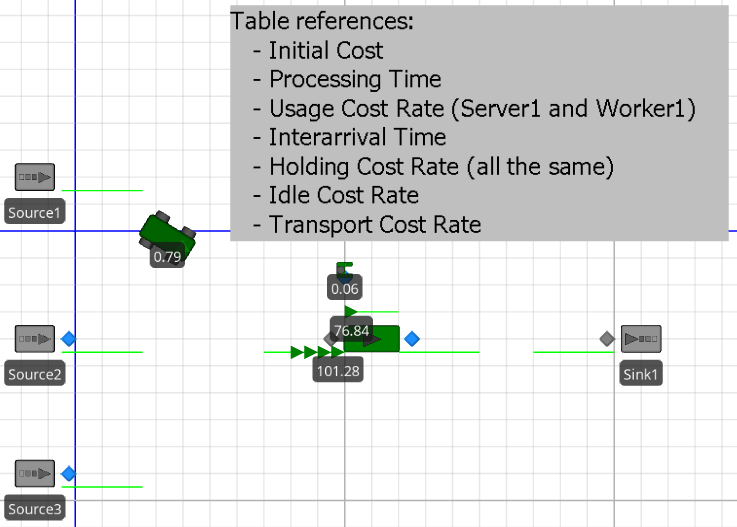






.thumb.jpg.d86860331a58e852a3b64f28348c2d88.jpg)
